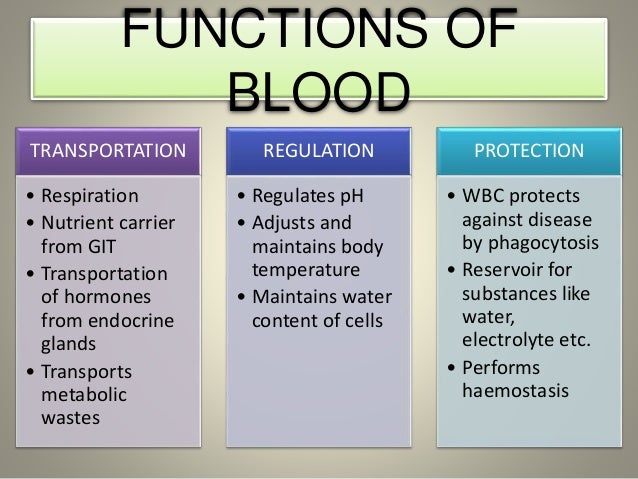BLOOD TRANSFUSION

Blood
Blood is a body fluid in humans and other animals that delivers necessary substances such as nutrients and oxygen to the cells and transports metabolic waste products away from those same cells. In vertebrates,it is composed of blood cells suspended in blood plasma.
Blood is a combination of plasma and cells that circulate through the entire body.Blood transports oxygen and nutrients around the body and removes cellular waste among a range of other vital functions.
- Plasma makes up 55 percent of blood content.
- The other 45 percent consists mainly of red blood cells and platelets.

Components of Blood
FROZEN PROF PLASMA (FFP)
PLATELETS
WHOLE BLOOD
Functions of Blood

Blood has a number of functions that are central to survival, including:
1.supplying oxygen to cells and tissues.
2.providing essential nutrients to cells, such as amino acids, fatty acids, and glucose.
3.Removing waste materials, such as carbon dioxide, urea, and lactic acid.
4.Protecting the body from infection and foreign bodies through the white blood cells.
5.Transporting hormones from one part of the body to another, transmitting messages, and completing important processes.
6.Regulating acidity (pH) levels and body temperature
engorging parts of the body when needed, for example
a penile erection as a response to sexual arousal.
a penile erection as a response to sexual arousal.
Another important function of the blood is its protective action against disease. White blood cells defend the body against infections, foreign materials, and abnormal cells.
The platelets in blood enable the clotting, or coagulation, of blood. When bleeding occurs, the platelets group together to create a clot. The clot becomes a scab and stops the bleeding, as well as helping to protect the wound from infection.
BLOOD TRANSFUSION
Blood transfusion is the process of transferring blood or blood products into one's circulation intravenously. Transfusions are used for various medical conditions to replace lost components of the Blood.
Transfusions are used for various medical conditions to replace lost components of the blood such as :- after an illness or injury after the blood loss during surgery.
Early transfusions used whole blood, but modern medical practice commonly uses only components of the blood, such as red blood cells, white blood cells, plasma, clotting factors, and platelets.

PURPOSE OF BLOOD TRANSFUSION
Many people who have surgery need blood transfusions because they lose blood during their operations.
Patient may need a blood transfusion if he\she have: A severe infection or liver disease that stops body from properly making blood or some parts of blood.
An illness that causes anemia, such as kidney disease or cancer.
TYPE OF BLOOD TRANSFUSION
1.Allogenic Blood Transfusion(someone else blood)
2.Autogenic Blood Transfusion(own blood)
3.Exchange Blood Transfusion
3.Exchange Blood Transfusion
ROLE & RESPONSIBILITY DURING BLOOD TRANSFUSION
Nursing care of the patient undergoing a blood transfusion is of utmost importance. Nurses are responsible not only for the actual administration of the blood product and monitoring of the patient during its administration but they also need to efficiently identify and manage any potential transfusion reactions.
The following is a step-by-step checklist of things to do and other responsibilities to ensure proper blood transfusion and prevent any unwanted reactions and errors.
1.Verify the physician’s written order and make a treatment card according to hospital policy.
2.Observe the Patient when preparing and administering any blood or blood components.
3.Explain the procedure/rationale for giving blood transfusion to reassure patient and significant others and secure consent.
4.Get patient histories regarding previous transfusion.
5.Explain the importance of the benefits on Voluntary Blood Donation.
6.Request prescribed blood/blood components from blood bank to include blood typing and cross matching and blood result of transmissible Disease.
7.Have a doctor and a nurse assess patient’s condition.
8.Counter check the compatible blood to be transfused against the cross matching sheet noting the ABO grouping and RH, serial number of each blood unit, and expiry date with the blood bag label and other laboratory blood exams as required before transfusion.
9.Get the baseline vital signs- BP, RR, and Temperature before transfusion.
10.Give Pre-medications 30 minutes before transfusion as prescribed.
11.Do hand hygiene before and after the procedure.
12.Prepare equipment needed for Blood transfusion.
13.IV hook, gloves, sterile 2×2 gauze or transplant dressing etc.
14.If main IV is with dextrose 5% initiate an IV line with appropriate IV catheter with Plain NS on another site anchor catheter properly and regulate IV drops.
15.Open compatible blood set aseptically and close the roller clamp.
16.Spike blood bag carefully fill the drip chamber at least half full prime tubing and remove air bubbles (if any).
17.Use needle g.18 or 19 for side drip (for adults) or gauze.22 for pediatric (if blood is given to the Y-injection port, the gauge of the needle is disregarded).
18.Disinfect the Y-injection port of IV tubing (Plain NS) and insert the needle, from B.T administration set and secure with adhesive tape.
19.Close the roller clamp of IV fluid of Plain NS and regulate it while transfusion is going on.
20.Transfuse the blood via the injection port and regulate at 10-15 drops/min initially for the first 15 minutes of transfusion and refer immediately to the Physician for any adverse reaction.
21.Observe/Assess patient on an on-going basis for any untoward signs and symptoms such as flushed skin,chills elevated temperature, itchiness, urticaria and dyspnoea.
22.If any of these symptoms occur, stop the transfusion,open the IV line with Plain NS and regulate accordingly and report to the doctor immediately.
23.Swirl the bag gently from time to time to mix the solid with the plasma N.B one B.T set should be used for 1-2 units of blood.
24.When blood is consumed, close the roller clamp and disconnect from IV lines then regulate the IVF of plain NS as prescribed.
25.Continue to observe and monitor patient post transfusion for delayed reactions.
26.Re-check HB and bleeding time, serial platelet count within specified hours as prescribed and/or per policy.
27.Discard blood bag and B.T set and sharps according to Health Care Waste Management/Bio Medical Waste Management.
28.Fill-out adverse reaction sheet as per institutional policy.
29.Remind the doctor about the administration of Calcium-gluconate if patient has several units of blood transfusion (3-5 more units of blood).
Acute Hemolytic transfusion reactions or complication related to blood transfusion
1.Sudden onset of fever with chills.
2.Headache,Dyspnea,Cynosis,Chest pain,Nausea,vomiting.
3.Increased heart rate or respiratory rate.
Hypo-tension followed by shock.

Written By:
Priyanka Massey
Infection Control Nurse & Professional Trainer
Ingenious Health Care Consultants Pvt.Ltd.


Your articles are enhancing my knowledge too. Thanks priyanka. Keep it up.
ReplyDeleteThanks sir for your motivating words..
ReplyDeleteVery nice article...
ReplyDelete